|
|
Sarah Fox's
Equipment Inventory
|
I initially wrote this page simply to list my equipment to prospective clients. However, it's morphed into more of a discussion of my equipment choices for other photographers. As I have a reputation for being a technogeek and am known to carefully research and test all of the equipment I buy, I'm often asked what equipment I use and why I chose it. The content of this page reflects many of my opinions, and as such, there is much on this page that should not be construed as irrefutable fact. Please note that this page was last updated in January 2010. It might be way out of date in as short as a year, so be forgiving if I don't seem current enough with my collection.
Anyone interested in more in-depth ramblings about my methodologies and equipment can check out a number of articles and web pages I've written, linked from this page.
This is a short list of my most used equipment:
- Camera bodies:
- Professional-grade lens collection, Canon EF mount:
- Consumer-grade lens collection, Canon EF mount:
- Classic, manual focus lenses I use for special projects:
- Meters and lighting equipment:
WHY I'M A CANON PHOTOGRAPHER
I use primarily Canon EOS equipment. Why Canon? Well, when I took my big plunge into DSLR cameras, Canon was the only serious player in the field. Nikon had their D70 and D100, but Canon simply dwarfed Nikon with their breadth of body and lens offerings, image processing technology, image stabilization technology, and support for professionals. Besides that, I still had bad memories of a Nikon F-501 (a.k.a. Nikon n2020) I had bought in the late 1980's. I considered it no big loss when I lost it in my divorce. (I greatly preferred my Pentax Spotmatic and Canon FD gear.) More recently, Nikon has come roaring back and is a viable competitor in the latter digital age. I welcome the competition, as it drives further technical development and price competition. As for the optics, Canon has come up in the world since Nikon's hayday in the F era, mostly because it chose to leap with both feet into the manufacture of serious professional gear. Interestingly, Lars Kjellberg, who I consider one of the best independent sources for lens test data, gives Canon lenses an average rating of 3.651, compared with Nikon's 3.499, based on rigorous, standardized optical testing. So Nikon no longer has the optical edge, and Canon no longer enjoys market dominance in DSLR bodies. The playing field is level. Anyway, for whatever it might matter, I'm a Canon photographer -- certainly no disrespect to Nikon photographers.
|
|
CAMERA BODIES
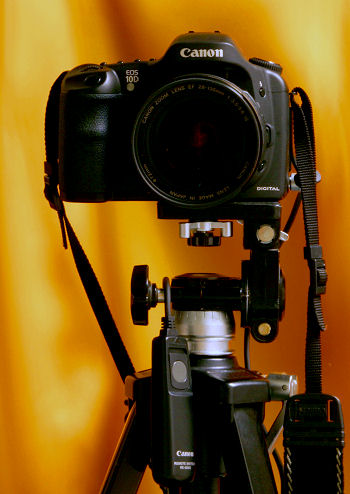

My first digital SLR, a Canon EOS 10D, pictured here, served me very well. I sold it long ago, but I have its picture here because practically every camera of this form factor, including my 5D and 40D, look almost exactly like it. I have since moved up to the Canon EOS 5D full-frame digital SLR (not pictured here), now the heart of my system. Its enormous, full frame, CMOS sensor (the size of a 35mm negative at 24mm x 36mm) collects much more light than the tiny CCD sensors of consumer-grade digital cameras and even 2.6 times larger than the APS-C format of more advanced consumer and prosumer cameras (e.g. the Digital Rebel series, the 50D, 60D, and Nikon's numerous equivalents). Full frame digital cameras are quite expensive, due to production complexities, but they offer numerous advantages to the photographer, including lower noise, higher light sensitivity, higher dynamic range, smoother tone representation, better saturation, better detail, brighter/larger viewfinders, more optimal utilization of the capabilities of wide angle lenses, the capability of shallower depths of field, and the easing of diffraction limits (so that a wider range of apertures may be used without diffraction blur). In some respects (max shooting speed at a given noise level, as well as the depth of field capabilities), having a full frame camera is equivalent to having slightly more than one full stop faster optics throughout one's lens collection. Those interested in Canon's full-blown technical discussion on the issue can find a great Canon "white paper" on the subject on a Nikon digital website here.
The 5D is one of the few cameras to become a classic very early in its production cycle and remaining a staple of professional photographers even after being superceded by a new model (the 5D Mark II). It is particularly loved by wedding photographers and those doing high end candid photography, due to its large format and compact form factor, as well as their relatively quiet shutters. Canon's full frame 1 series digital cameras are impressive machines of their own right and do some things the 5D will not (e.g. provide waterproofing in a heavy rainstorm); however, they are huge, heavy, and noisy. Some photographers like this, but I do not. The 5D has already been superceded in resolution and, in fact, wasn't even the world's highest resolution camera when launched (the title belonging to the 16 MP 1Ds Mark II). However, photographers have found its 12.8 MP resolution an excellent compromise between resolution and sensitivity. Higher resolution would mean smaller pixels (therefore higher image noise and lower sensitivity to light), while yielding no appreciable benefit to image quality. When Nikon launched a number of full frame digital cameras in response to Canon's, this was the resolution of sensor they chose to implement, as well. There now exists a divergence between Nikon and Canon. Canon continues to push the bounds of resolution, while Nikon continues to improve the quality of the pixel. Canon's 5D may well be the last point where Nikon and Canon found common ground in design philosophy, with the 12.8 MP format Nikon now seems to prefer (but see the G11 below).
|
|
There are still a couple of things a crop frame (APS-C) camera will do that a full frame camera will not. Foremost among these things is the suitability of the camera for telephoto photography. The 1.6x crop factor makes a telephoto lens seem "longer" (more powerful), so that telephoto photography can be performed with smaller, lighter, and less expensive optics. Looking at it another way, one's telephoto capabilities are augmented with the lens collection one already has. My crop frame camera of choice is the Canon EOS 40D (not to be confused with Nikon's entry level D40), not pictured here. In addition to being great for telephoto photography, it is very light, cranks out an impressive 6 frames per second, and has live view (usually not useful, but sometimes indespensible). The 40D has better noise handling properties and greater resolution than its predecessor the 30D and much better noise and sensitivity properties than its APS-C successors, so far. Its 10.1 MP resolution is appropriate for what it does. Higher resolution wouldn't appreciably improve image quality but would introduce noise and reduce sensitivity. I very much like the 40D, as it is "just right" for a number of tasks.
|

 I do sometimes shoot film, for instance when a client has a particular preference for film or when I'm interested in extroardinarily long exposures. My Canon EOS Elan 7n (pictured) and EOS 1n (not pictured) are both very competent camera bodies. The professional 1n body has weather sealing for rainy days but has a bit noisier a shutter than I normally like. The Elan 7n is a very smooth, quiet, and unobtrusive camera body, although it has a bit more plasticky feel to it.
I do sometimes shoot film, for instance when a client has a particular preference for film or when I'm interested in extroardinarily long exposures. My Canon EOS Elan 7n (pictured) and EOS 1n (not pictured) are both very competent camera bodies. The professional 1n body has weather sealing for rainy days but has a bit noisier a shutter than I normally like. The Elan 7n is a very smooth, quiet, and unobtrusive camera body, although it has a bit more plasticky feel to it.
|
|
Canon Powershot G11: It's said the best camera is the one you have with you. I decided long ago to carry a camera with me at all times. Of course even a 40D with an 18-55IS is somewhat bulky and heavy. The Powershot G series was developed mostly for serious photographers traveling light, and it's been wildly popular amongst press photographers. The G11 is the latest in the G series. In an effort to improve the low light performance of the camera, the G11 actually has fewer megapixels than the G10 (10MP, rather than 14.8). This break from the ridiculous megapixel wars might be the most intelligently development in compacts in a very long time! The G11 features a very nice 28-140mm equivalent f/2.8-f/4.5 lens, all manual controls, RAW encoding, a hot shoe, and an optical viewfinder. A less obvious feature is an X-sync speed of 1/2000 sec (although it's more like 1/500 when dumping full charges from slave strobes). There are actually rare situations in which the G11 can grab a shot that my 40D or 5D cannot, simply by virtue of its higher X-sync speed. Limitations are typical for micro-format cameras -- diffraction limitations around f/5.6, higher noise and lower sensitivity than a DSLR, and an awkward user interface (albeit far better than anything else I've seen in a compact). Despite its limitations, it has quite good low light performance and can generate very decent photos up to ISO 800 (or even 1600). It's also a rather "cool" looking camera. When I'm not using my G11, it's' busy cooking, cleaning, walking the dog, fielding phone calls, and writing poetry. I think it's the most feature packed piece of equipment I've ever owned.
|
|
PROFESSIONAL-GRADE LENS COLLECTION, CANON EF MOUNT
My Sigma AF 12-24mm f/4.5-5.6 EX DG Aspherical HSM, in Sigma's professional EX series, is not my very best lens, but it's probably the greatest feat of optical engineering in my entire collection. It has proven itself indespensible for interior architectural photography, getting me into small spaces where no other lens can tread. It is tied with the new APS-C format Sigma 8-16mm (a scale-down 12-24 with essentially the same design?) and the Voigtlander 12mm prime as the widest angle rectilinear lens ever designed. Unlike the Voigtlander, it is designed with a long focal-plane-to-lens clearance that enables its use on an SLR. So advanced was the design that it won Sigma the 2004/2005 EISA lens of the year award. This lens enables me to simultaneously photograph all four walls of a rectangular room, with grazing shots of the nearest two walls. Although there are shorter lenses (e.g. in the 10mm range in both the Canon and Nikon lineup, these lenses are designed for the smaller format of the APS-C sensors and are actually equivalent to 16mm lenses in the full-frame (35mm) format. Shooting with such a wide lens may seem like overkill, but rooms almost never appear as large in a photograph as they seem in person, due to limitations in view angle. This is particularly true for small rooms like bathrooms. I boast that my ultra-wide architectural capabilities are the best in the industry for the following reasons: (1) No other photographer has a wider lens. (2) A good copy of this $1000 lens rivals the optical quality of even Canon's and Nikon's ultrawides, none of which are as wide. And most of all, (3) Very few professionals are able to find the lens I have found. Build quality varies enormously for ultrawide lenses, even amongst the top manufacturers, and Sigma has more than its share of problems in this cutting edge lens, with the finished product rarely living up to specifications. I bought, tested, and returned a number of these lenses before being lucky enough to find the rare one that is "perfect." Very few photographers are this lucky. More information on this wondrous lens can be found here.
|

 The Canon EF 17-40mm f/4L USM is the widest of my Canon L series lenses. The "L" stands for "luxury" and denotes a higher standard of build, including low dispersion optics, aspherical elements, weatherproofing, and a rock-solid build that will hold up to professional abuse. This lens is probably my favorite for landscape photography. Its optics are tack sharp, and it exhibits almost no chromatic aberration or vignetting. Its one weakness is that it barrels a bit when zoomed out wide; however, that is easily corrected in postprocessing. Build is excellent, and the lens coatings are particularly noteworthy -- best I've seen on any lens.
The Canon EF 17-40mm f/4L USM is the widest of my Canon L series lenses. The "L" stands for "luxury" and denotes a higher standard of build, including low dispersion optics, aspherical elements, weatherproofing, and a rock-solid build that will hold up to professional abuse. This lens is probably my favorite for landscape photography. Its optics are tack sharp, and it exhibits almost no chromatic aberration or vignetting. Its one weakness is that it barrels a bit when zoomed out wide; however, that is easily corrected in postprocessing. Build is excellent, and the lens coatings are particularly noteworthy -- best I've seen on any lens.
It is worth discussing, here, why I use f/4 zoom optics, rather than f/2.8 optics. Many professional photographers prefer the f/2.8 optics for their low-light handling abilities and their ability to deliver a shallower depth of field and therefore create a larger background blur. This decision comes down largely to photographic style. I will sometimes rely on extremely shallow depths of field, and I am equipped with wide-aperture prime lenses for that purpose, but the lion's share of my work is done between f/5.6 and f/11, with the objective of maximizing depth of field, while not sacrificing sharpness due to lens diffraction. Considering my shooting style, f/2.8 optics are unneccessarily expensive, heavy, and conspicuous. Beyond these obvious factors, however, f/4 optics are better optimized for smaller aperture photography and deliver superior results to f/2.8 optics (which are better optimized for wide-open shooting). What do I do when I want to shoot a picture with a very thin depth of field, yielding an extreme background blur? Rather than having fewer lenses that do everything, I've opted to have more numerous lenses that better satisfy the various niches in my photographic requirements. Rather than to have f/2.8 capabilities on my zoom lenses, I prefer to have f/1.8 and f/2.0 capabilities in a couple of prime lenses that deliver superb results at these large apertures. I am not able to dial in these capabilities on the fly, as with the 24-70mm f/2.8L lens. However, with a few moments to change my lens, I can get an even better shot with one of my fast primes.
|
|
The Canon EF 24-105 f/4L USM lens (not pictured) is probably my best lens overall. That's important, because it's also my most used lens. It is mounted to my camera most of the time and takes perhaps half of my shots. It's not surprising that this lens is a workhorse for professional photographers. Pick any lens model, and you'll find good copies, bad copies, and lots of inbetween copies. My copy of the 24-105 greatly exceeded my expectations and produces superior image quality to the (already superb) sample images from other photographers, which had formed the basis of my purchasing decision. Images are tack sharp from corner to corner, with little or no chromatic aberration. The build and the balance of the lens are superb. The image stabilization is intuitive and works flawlessly. The best and most extraordinary thing I can say about this lens is that its image quality is about the same wide open as it is stopped down to f/8 or f/11, and it is about the same at 24mm as it is at 105mm, as it is at 50mm. In other words, there are no "sweet spots." Rather, the lens is "sweet" throughout its entire range of operating parameters. The only down-side to this lens is the rather strong vignetting that occurs at the 24mm end. That is easily corrected in postprocessing, although it does diminish dynamic range a bit in the corners. Where this is a potential problem, I can always use my 17-40.
By the way, some people wonder why my zoom ranges overlap as much as they do (e.g. 17-40, 24-105, and 70-200). There are two reasons: First, lenses often have slight deficits at the extremes of their zoom ranges, so overlap ensures these extremes can be avoided. Second, overlapping zoom ranges mean fewer lens changes, meaning less lost shooting time, more efficient work output for the client, and less dust exposure for the digital sensor.
|
|
My EF 70-200 f/4L IS USM lens (not pictured) is arguably Canon's sharpest and best behaved zoom. It represents the top end of my 12-200mm professional optical capabilities. Although I have longer consumer lenses than this one, 200mm is about the extent of anything I need professionally. Photographers often have very sharp disagreements between the merits of this lens and its f/2.8 version. The reason is that the f/2.8 (especially IS) lens is an excellent choice when the bulk of one's work is handheld portraiture. However, as discussed above, I fill this need in my lens collection with a large prime -- my 100mm f/2.0, which yields superior results to the 70-200 f/2.8L for this purpose. At smaller apertures, this lens outperforms the f/2.8 version, while still having a very pleasing bokeh. Performance is very consistent across all operating parameters. Unique features on this lens are the dual mode image stabilization, suited for both stationary and panning situations, and the internal focus and zoom. The latter feature does make the lens very long and somewhat awkward to carry, but it avoids drawing air into and out of the camera body during zooming and focusing, which is important in moist and dusty conditions alike. My 17-40mm f/4L also features internal focus and zoom, provided a UV filter is used to seal the front of the lens. However, this feature is much more important on a tele zoom, which draws so much more air while zooming. |
|
My EF 100 f/2.0 USM lens (not pictured) is my "big gun" for portraiture. It does not technically qualify for Canon's professional "L" designation. This is through no fault of the optics, which are among Canon's very best. Rather, the mechanical parts of the lens are of a lighter duty and are not weather sealed. That said, professional photographers do consider this a professional lens and use it as such. The strength of this lens is for full-frame portraiture. The lens is one of Canon's sharpest lenses from corner to corner at this aperture. Because of the extremely large aperture, the minimum depth of field can be razor thin, if desired. This lens has what I would call a "neutral" bokeh, meaning that spherical aberration is well corrected but not overcorrected, resulting in a blur pattern without a harsh edge ring. A bokeh pattern such as this can be creamy with most subject matter, while retaining the ability to create beautiful background highlights from "city lights."
This lens is very similar to Canon's EF 85mm f/1.8, which is probably their most popular portrait lens. I prefer the slightly longer focal length of the 100, but this decision really comes down to shooting style. The bokeh in the 85/1.8 is touted to be quite smooth, similar to the 100/2. It is curious, though, that the 85 has sometimes tested rather poorly in edge sharpness. This is reflected somewhat in Canon's own MTF data, but also in some rather astonishing test data (particularly in the full frame format) from SLRGear. (Perhaps they received a bad copy?) Upon seeing some convincing test images on the web from this lens, I don't know whether these test results are quite fair to the lens. It is possible that field curvature has resulted in these discrepancies, such that the corners of a flat target would be out of focus if the center is in focus.
Also in this family is Canon's exotic 85mm f/1.2L II USM lens -- at over $2000. (Not many people own this lens -- not even the pros-- and I simply couldn't justify this cost for an occasional-use lens.) A much underappreciated lens sometimes used for portraiture is Canon's 100mm f/2.8 macro, which delivers superb sharpness from corner to corner. However, the 100/2.0 is faster/larger and delivers almost the same fine-grained sharpness. In the same category as the 100/2.8 macro is Nikon's classic 105mm f/2.5, which many have argued is the best portrait lens ever made by any manufacturer. I own and use this lens (which I've adapted to my Canon EF mount), but frankly I consider the 100/2.0 a better portrait lens, owing to its larger maximum aperture.
|
|
CONSUMER-GRADE LENS COLLECTION, CANON EF MOUNT
When a professional photographer has invested thousands of dollars in professional-grade optics, why would she still have any consumer-grade optics? There are at least a couple of good reasons. The first and most obvious is that some accident or malfunction could put one of the pro lenses out of commission, and a backup would be required until the necessary repairs could be completed. Every conscientious pro photographer has backups of all equipment, so as to insure rock-solid, reliable service to the client. I have two digital bodies, two film bodies, two of every focal length of lens, two light meters, a half dozen flash units, multiple flash triggering methods (hardwired, IR, RF, optical), and so forth. If anything fails I'll still be operational, albeit perhaps not with my favorite equipment. Beyond that, there are hazardous situations in which I would not want to risk my very best equipment, for instance while doing wildlife photography from a canoe. Finally, there are some consumer grade lenses that, for one reason or another, perform to professional standards and can be used as such.
My MC Zenitar 16mm f/2.8 diagonal fisheye lens (not pictured) is a truly unusual find. Were it not for the poor machine tolerances and quality control deficiencies, I'd probably classify it as a professional grade lens because of optical performance alone. I was fortunate to find an optically excellent copy with a couple of manufacturing flaws I was able to fix. I do use it professionally on odd occasions that I need a fisheye geometry, rather than a wide rectilinear geometry. The lens is of Russian manufacture, a hangover from the old Soviet military industrial era. I understand the lens might have been used for missile guidance systems. Although the build of this lens is not really up to Western standards, it nevertheless has the distinction of greatly outperforming some very fine optics from Canon and Nikon of several times the cost! I use this lens rarely -- for ultra-wide shots involving people/faces and other round objects I don't want to distort. (If I were to use the Sigma, which keeps lines and angles intact, round objects in the margins would be stretched into ovals.) I did a writeup on this extroardinarly little lens here.
|
|
My EFS 18-55 f/3.5-5.6 IS lens is a little $100 wonder. It's not to be confused with the non-IS version, which is optically inferior. Most people would consider this humble little lens a piece of junk, and I suppose it is. The design of the lens is very basic, and the build quality leaves much to be desired (e.g. plastic mount, rotating front element, non-USM focus). However, it's also got a few good things going for it. First of all, it's really quite sharp, and the simple optical design results in very high contrast images. Its only weakness, optically, is that chromatic aberration is not well controlled. There are postprocessing solutions to that problem, and it certainly would not be the first lens with this problem. Nikon enthusiasts like to boast that their junky 18-55 counterpart is the superior lens, but objective tests really show it's a bit of a draw. Canon's junky lens is slightly sharper. Nikon's junky lens has slightly less chromatic aberration. The reason I own and use this lens is that it is tiny and feather-light. I like to carry a camera with me wherever I go, just "in case." My preferred carry-around rig at this time is my 40D with this lens mounted up. When I'm out with more specific photographic objectives, I'll usually carry my 5D with my 24-105 mounted up, but I'll return with a sore neck. I will add that despite its simplified design, the performance of the image stabilization on this lens is nothing short of superb. The only limitation is that the range of correction is perhaps not as great as one might have on other IS lenses. However, it's rock-solid stable.
|
|
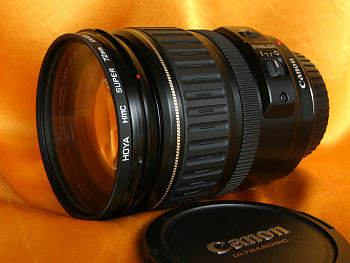
 The first EF lenses I acquired were very well performing consumer grade models, somewhat lacking in build quality, but excellent optically. My 28-135mm f/3.5-5.6 IS USM, now semi-retired, was the first of such acquisitions. Although I don't use this lens much, it does have its uses. I mount it (or my 75-300, below) up to my 40D to take out on the water, whether in our 27'cabin cruiser or even in a canoe. When out on the water with any camera, I seal it inside a snap-lid plastic bucket, which is air-tight and will float in the event of the unthinkable. This upper-middle lens performs well above average for a zoom. Its distortion is very minimal, and its chromatic aberration is quite well controlled, except at extremely wide focal lengths. This has got to be Canon's most under-appreciated lens, as it was produced in such great numbers as a kit lens for the older film bodies and is somewhat bulky for the APS-C digitals. The lens can be found rather cheaply on the used market by the patient Ebayer.
The first EF lenses I acquired were very well performing consumer grade models, somewhat lacking in build quality, but excellent optically. My 28-135mm f/3.5-5.6 IS USM, now semi-retired, was the first of such acquisitions. Although I don't use this lens much, it does have its uses. I mount it (or my 75-300, below) up to my 40D to take out on the water, whether in our 27'cabin cruiser or even in a canoe. When out on the water with any camera, I seal it inside a snap-lid plastic bucket, which is air-tight and will float in the event of the unthinkable. This upper-middle lens performs well above average for a zoom. Its distortion is very minimal, and its chromatic aberration is quite well controlled, except at extremely wide focal lengths. This has got to be Canon's most under-appreciated lens, as it was produced in such great numbers as a kit lens for the older film bodies and is somewhat bulky for the APS-C digitals. The lens can be found rather cheaply on the used market by the patient Ebayer.
|
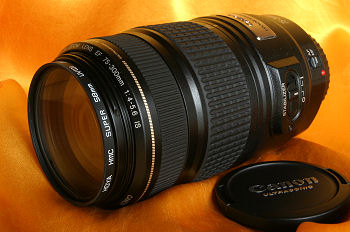
 The Canon EF 70-300mm f/4-5.6 IS USM is the upgraded version of the 75-300 f/4-5.6 IS USM lens (which I previously owned; pictured here -- looks almost identical), which was the sister lens to the 28-135. Unlike the 75-300 IS, which often yielded some superb results, but which would often disappoint, the 70-300 is a more consistent performer, with much improved sharpness across a greater span of aperture and focal length. The lens rivals my 70-200L in sharpness when stopped down slightly, but it is not as well built (not as rigid, sturdy, weatherproof; has rotating front element). This lens is quite compact and is great for nature walks. I prefer the heavier/bulkier 70-200/4L for candid portraiture. As I don't do much professional work beyond 200mm, I'm not particularly concerned that this is not Canon's very best offering at 300mm. Extending my focal length capabilities even further, I sometimes use a Kenko Pro-300 1.4x teleconverter. With this optic, my 70-200mm lens becomes a weather-sealed 280mm lens (448mm equivalent on my 40D) with "very good" image quality. My 70-300mm lens becomes a 420mm lens (672mm equivalent on my 40D) of "good" quality. For even more reach, I use my Takumar 500mm f/4.5 with 2x Komura teleconverter on a crop camera. I wouldn't use these optics professionally, but they're fun to play around with on my time off.
The Canon EF 70-300mm f/4-5.6 IS USM is the upgraded version of the 75-300 f/4-5.6 IS USM lens (which I previously owned; pictured here -- looks almost identical), which was the sister lens to the 28-135. Unlike the 75-300 IS, which often yielded some superb results, but which would often disappoint, the 70-300 is a more consistent performer, with much improved sharpness across a greater span of aperture and focal length. The lens rivals my 70-200L in sharpness when stopped down slightly, but it is not as well built (not as rigid, sturdy, weatherproof; has rotating front element). This lens is quite compact and is great for nature walks. I prefer the heavier/bulkier 70-200/4L for candid portraiture. As I don't do much professional work beyond 200mm, I'm not particularly concerned that this is not Canon's very best offering at 300mm. Extending my focal length capabilities even further, I sometimes use a Kenko Pro-300 1.4x teleconverter. With this optic, my 70-200mm lens becomes a weather-sealed 280mm lens (448mm equivalent on my 40D) with "very good" image quality. My 70-300mm lens becomes a 420mm lens (672mm equivalent on my 40D) of "good" quality. For even more reach, I use my Takumar 500mm f/4.5 with 2x Komura teleconverter on a crop camera. I wouldn't use these optics professionally, but they're fun to play around with on my time off. |
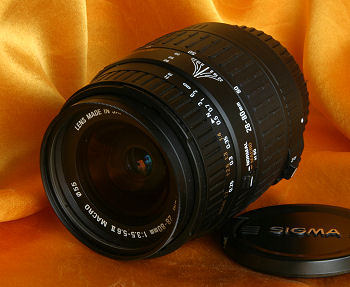
 I'm not sure why I still have my Sigma AF 100-300mm f/4.5-6.7 DL (not shown in this photo). Maybe it's a backup to my backup. I mention it here because it's an amazingly good value, if someone requires a trashable lens with not-too-bad image quality. So is its companion, the Sigma AF 28-80mm f/3.5-5.6 II Macro (shown in the photo, sold with my old EOS 10D). You'll sometimes find these lenses bundled together for around $150. They're really quite OK -- not great, but really not bad.
I'm not sure why I still have my Sigma AF 100-300mm f/4.5-6.7 DL (not shown in this photo). Maybe it's a backup to my backup. I mention it here because it's an amazingly good value, if someone requires a trashable lens with not-too-bad image quality. So is its companion, the Sigma AF 28-80mm f/3.5-5.6 II Macro (shown in the photo, sold with my old EOS 10D). You'll sometimes find these lenses bundled together for around $150. They're really quite OK -- not great, but really not bad.
|
|
CLASSIC, MANUAL FOCUS LENSES I USE FOR SPECIAL PROJECTS:
My Takumar SMC 55mm f/1.8 lens, which I originally used with my Spotmatic F, was among the best of the optical lineup of Pentax, when the company was in its prime in the 1970's. I couldn't let this wonderful lens gather dust, so I adapted it to my EOS system for use as a portrait length lens with respect to APS-C sensors. Its coatings were unsurpassed in the industry and even still rival the flare suppression of modern day professional lenses. That's not to mention that it's sharp!
|
|
My Nikkor 105mm f/2.5 manual focus lens enjoyed legendary status in the 1970's as the best 35mm format portrait lens ever made, and many photographers argue that it hasn't lost this status. My lens is in beautiful condition and produces some of the sharpest images I've seen. Although I would argue that my Canon EF 100mm f/2.0 is every bit as good a portrait lens, if not better in some respects, you really have to respect this little Nikkor. I hope my colleagues won't be horrified that I take advantage of its relatively simple construction to do experimental work, such as on alternative apertures and their bokeh patterns.
|
|
My Takumar SMC 135mm f/3.5 lens, like the 55mm f/1.8 above, features virtually unsurpassed sharpness and flare reduction. Although I have no particular use for the lens at this time, I can still use it if the occasion arises, with the adapter I bought for my 55. I'm listing the lens here mostly with the intent of including test data and sample images I hope to post on all my lenses when I have more free time. I just think it's a great lens, and the data should be findable somewhere on the Internet.
|
|
My Takumar SMC 500mm f/4.5 lens is somewhat of a recent experiment (summer 2012). It's one of those grand old 70's lenses that's both affordable and fun. This collosal beast would be ridiculously awkward to handhold or even to carry around. Its only reasonable use is on a tripod -- a sturdy one. Like pretty much all of the 70's era supertelephotos, this lens suffers a bit from spherical aberrations, particularly coma. However, it's quite sharp. I am combining it with a Komura 4 element 2x teleconverter (supposedly better than the 7 element design on extreme telephoto lenses) to photograph large birds off of our shores. The images are standing up pretty well, so far. With this lens and TC combination on a crop body camera, my equivalent focal length is 1600mm. Fair warning: I have to stop this lens down to about f/9.5 (a half stop past f/8) to rid the lens of the bulk of its chromatic aberration problems. Then with the 2x TC, I'm shooting at f/19, which is probably where this lens starts getting into diffraction limitation territory.
The older mirror telephotos might yielder sharper images with less chromatic aberration, but they suffer from a horrible "donut bokeh." It was for this reason that I chose to try out this monster refracting lens. Besides that, these lenses start at f/8 (where the Takumar gets good), and a mirror f/8 is not as good as a refractor f/8, as the focus is much, much fussier, with much thinner depth of field and very objectionable bokeh.
Anyway, my 500/4.5 and 2XTC combo are an experiment in progress as I write. I may later describe my "pentapod" that I made just for stabilizing this awkward rig. If I haven't, feel free to drop me a note to ask about it.
|
|
METERS AND LIGHTING EQUIPMENT:
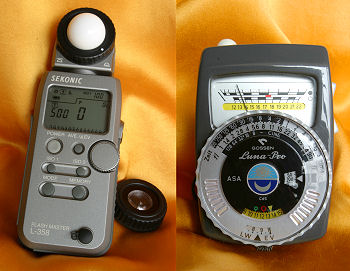
 I'm pretty old-fashioned when it comes to calculating exposure. In fact I've adapted much of my technique from Ansel Adams' zone system. Unlike Adams, I work with color photography and digital format, both of which require modification of the traditional zone approach. Some of these modifications are widely discussed on the Internet. One of them is not -- and is a trade secret of mine, at least for now. My meter of choice remains my 1970's vintage Gossen Luna Pro CDS (right), which I have recalibrated to use modern silver-oxide cells. (Click here to find out how.) I find that it is dead-accurate and measures light levels a few stops lower than the lowest sensitivity limits of my 10D and my modern Sekonic meter (left). However, my Sekonic Flash Master L-358 is indispensable for setting up flash lighting and balancing it intelligently with ambient light.
I'm pretty old-fashioned when it comes to calculating exposure. In fact I've adapted much of my technique from Ansel Adams' zone system. Unlike Adams, I work with color photography and digital format, both of which require modification of the traditional zone approach. Some of these modifications are widely discussed on the Internet. One of them is not -- and is a trade secret of mine, at least for now. My meter of choice remains my 1970's vintage Gossen Luna Pro CDS (right), which I have recalibrated to use modern silver-oxide cells. (Click here to find out how.) I find that it is dead-accurate and measures light levels a few stops lower than the lowest sensitivity limits of my 10D and my modern Sekonic meter (left). However, my Sekonic Flash Master L-358 is indispensable for setting up flash lighting and balancing it intelligently with ambient light.
|
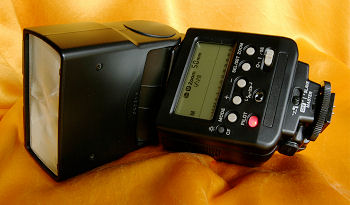
 My primary flash is Canon's excellent Speedlite 550-EX, an extremely powerful and sophisticated flash that is bettered only by Canon's more recent (and slightly more powerful) 580EX. It is very well suited for bounce lighting and special effects photography and has provided single-source lighting for some of my best images. However, as a rule, I use flash only reluctantly, and only where natural lighting cannot be used. That is why I am so heavily invested in image stabilization technology.
My primary flash is Canon's excellent Speedlite 550-EX, an extremely powerful and sophisticated flash that is bettered only by Canon's more recent (and slightly more powerful) 580EX. It is very well suited for bounce lighting and special effects photography and has provided single-source lighting for some of my best images. However, as a rule, I use flash only reluctantly, and only where natural lighting cannot be used. That is why I am so heavily invested in image stabilization technology.
|
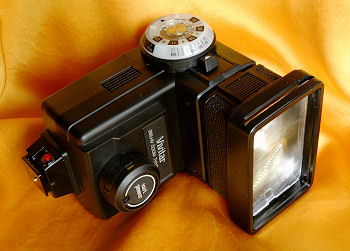
 When I do flash photography, I prefer to set up multiple light sources. Canon's Speedlite system has excellent wireless capabilities for balancing multiple flashes with ETTL metering. However, the transmission range and angle are lacking. (The system should be designed with longer-range radio frequency remote!) Furthermore, there are no provisions for balancing flash intelligently against ambient light. Therefore, to do a really good job of flash photography, it is necessary to set up lighting manually. These Vivitar 285hv flashes are workhorses of the industry, as they are enormously powerful and are very well suited for off-shoe work. Furthermore, they are manually controllable at variable power. I use up to 6 flashes for my lighting, usually diffused by umbrellas or soft boxes. I have modified these flashes to recycle off of sealed lead acid batteries and automatic chargers, reducing their recycle time to approximately 2 seconds. (There's a great "how-to" article about it here.) I've also modified them with a more-or-less continuous manual level adjustment from 1/64 power to full power, as well as 1/4" sync jacks. My own "how-to"page can be found here.
When I do flash photography, I prefer to set up multiple light sources. Canon's Speedlite system has excellent wireless capabilities for balancing multiple flashes with ETTL metering. However, the transmission range and angle are lacking. (The system should be designed with longer-range radio frequency remote!) Furthermore, there are no provisions for balancing flash intelligently against ambient light. Therefore, to do a really good job of flash photography, it is necessary to set up lighting manually. These Vivitar 285hv flashes are workhorses of the industry, as they are enormously powerful and are very well suited for off-shoe work. Furthermore, they are manually controllable at variable power. I use up to 6 flashes for my lighting, usually diffused by umbrellas or soft boxes. I have modified these flashes to recycle off of sealed lead acid batteries and automatic chargers, reducing their recycle time to approximately 2 seconds. (There's a great "how-to" article about it here.) I've also modified them with a more-or-less continuous manual level adjustment from 1/64 power to full power, as well as 1/4" sync jacks. My own "how-to"page can be found here.
|

 I bet I'm the only photographer in the world who owns a Sunpak Auto 266D oil lantern! I had to make it, of course. The reason I fabricated this odd device is that I needed to light a scene very brightly, but still with lantern light. The only way to do that was to gut a perfectly good Sunpak/Canon FD type flash, hot-glue the innards into a foam-core box, and fit (CRAM) the box into the base of an old oil lantern. The flash is triggered by a built-in Sonia optical slave and is color-corrected with a CTO gel. It of course no longer has auto exposure, but it does have continuously variable power in two selectable ranges. I highly recommend this model of flash for anyone who needs to cannibalize one. It's inexpensive, moderately powerful, and very fast to recycle.
I bet I'm the only photographer in the world who owns a Sunpak Auto 266D oil lantern! I had to make it, of course. The reason I fabricated this odd device is that I needed to light a scene very brightly, but still with lantern light. The only way to do that was to gut a perfectly good Sunpak/Canon FD type flash, hot-glue the innards into a foam-core box, and fit (CRAM) the box into the base of an old oil lantern. The flash is triggered by a built-in Sonia optical slave and is color-corrected with a CTO gel. It of course no longer has auto exposure, but it does have continuously variable power in two selectable ranges. I highly recommend this model of flash for anyone who needs to cannibalize one. It's inexpensive, moderately powerful, and very fast to recycle.
|
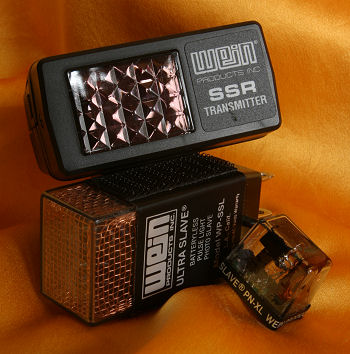
 I am able to avoid head-on lighting of the subject (think forehead shine and red-eye) and minimize the bulk of my camera by using this Wein infrared UltraSlave system. It consists of a tiny, fast-recycling infrared flash and two extremely sensitive infrared receivers. These units trigger the primary (most powerful) flashes.
I am able to avoid head-on lighting of the subject (think forehead shine and red-eye) and minimize the bulk of my camera by using this Wein infrared UltraSlave system. It consists of a tiny, fast-recycling infrared flash and two extremely sensitive infrared receivers. These units trigger the primary (most powerful) flashes.
|
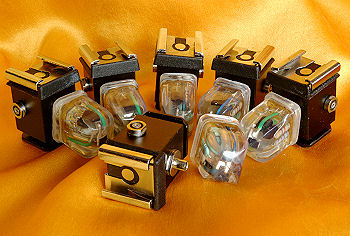
 Once the primary flashes fire, light fills the room, triggering these conventional optical slaves. I actually found these little beauties on Ebay, and I wrote this paragraph for the consumption of other photographers who might need some unbiased, objective test data on how they perform. (FTC Mandated Disclaimer: Danger! This benefits both an Ebay seller with sales and myself with web traffic. See here.) The base is extremely rugged, all-metal construction, and the plug-in trigger units are extremely sensitive. One caveat: They trigger my Vivitar 285 flashes just fine, but they didn't get along so nicely with my Canon 550-EX. I had to modify one of the slave bases for this flash by bypassing the three diodes inside it. With this modification, it works great. (Access is gained by lifting and sliding out the spring clip on top, removing the three screws, and inserting a small screwdriver to push the round back-plate off of the backside. Use very fine wire to bypass the diodes, and be very brief in your soldering!) There are no published specifications on these units, made by Sonia (Indian); however, I'll offer my own test results on 6 units, for those who are interested. (All units performed the same.) At 0 deg, head-on, they trigger at a maximum distance of approx. 8*GN. At 90 deg, to the side, they trigger at about 2.7*GN. Even at 135 deg (45 deg to the rear), they trigger at approx. 2*GN. These figures are calculated from test results using the Canon 550-EX at 50mm, fired in a large room at 1/128 of full power and reduced further in intensity by two stops. At this power, I could trigger the slave at 50 ft. At full power, I estimate I could trigger the slave at over 1000 ft. Note that it is not possible to do slave synchronization in the HS mode, but my tests indicated satisfactory synchronization up to 1/200s. I should also point out that this optical slave will not trigger in a strongly lit environment, such as in direct sunlight. For that matter, I've not found any optical slaves that will do that, including my Wein units. (Anyone wanting to trigger in such an environment needs a radio slave, such as a Pocket Wizard or even one of the cheap Ebay-variety units made in China.) This optical slave unit is extremely versatile, with two sync cord connectors on either side of the base, in addition to the hot shoe connection. These connectors can be connected to infrared or RF remote triggers for dual-triggering. The devices have a few rough edges, characteristic of Indian manufacture. For instance, the threaded hole at the bottom is a through-hole, not a blind hole, so one must take care not to thread a screw in too far, to avoid contacting the internal wiring. However, with a bit of care, these slaves perform flawlessly and are extremely inexpensive. I would highly recommend them to other budget-conscious professionals. You can find them on Ebay from this seller.
Once the primary flashes fire, light fills the room, triggering these conventional optical slaves. I actually found these little beauties on Ebay, and I wrote this paragraph for the consumption of other photographers who might need some unbiased, objective test data on how they perform. (FTC Mandated Disclaimer: Danger! This benefits both an Ebay seller with sales and myself with web traffic. See here.) The base is extremely rugged, all-metal construction, and the plug-in trigger units are extremely sensitive. One caveat: They trigger my Vivitar 285 flashes just fine, but they didn't get along so nicely with my Canon 550-EX. I had to modify one of the slave bases for this flash by bypassing the three diodes inside it. With this modification, it works great. (Access is gained by lifting and sliding out the spring clip on top, removing the three screws, and inserting a small screwdriver to push the round back-plate off of the backside. Use very fine wire to bypass the diodes, and be very brief in your soldering!) There are no published specifications on these units, made by Sonia (Indian); however, I'll offer my own test results on 6 units, for those who are interested. (All units performed the same.) At 0 deg, head-on, they trigger at a maximum distance of approx. 8*GN. At 90 deg, to the side, they trigger at about 2.7*GN. Even at 135 deg (45 deg to the rear), they trigger at approx. 2*GN. These figures are calculated from test results using the Canon 550-EX at 50mm, fired in a large room at 1/128 of full power and reduced further in intensity by two stops. At this power, I could trigger the slave at 50 ft. At full power, I estimate I could trigger the slave at over 1000 ft. Note that it is not possible to do slave synchronization in the HS mode, but my tests indicated satisfactory synchronization up to 1/200s. I should also point out that this optical slave will not trigger in a strongly lit environment, such as in direct sunlight. For that matter, I've not found any optical slaves that will do that, including my Wein units. (Anyone wanting to trigger in such an environment needs a radio slave, such as a Pocket Wizard or even one of the cheap Ebay-variety units made in China.) This optical slave unit is extremely versatile, with two sync cord connectors on either side of the base, in addition to the hot shoe connection. These connectors can be connected to infrared or RF remote triggers for dual-triggering. The devices have a few rough edges, characteristic of Indian manufacture. For instance, the threaded hole at the bottom is a through-hole, not a blind hole, so one must take care not to thread a screw in too far, to avoid contacting the internal wiring. However, with a bit of care, these slaves perform flawlessly and are extremely inexpensive. I would highly recommend them to other budget-conscious professionals. You can find them on Ebay from this seller.
|
|
In some settings it is difficult to use optical or IR slaves. For instance, they won't trigger in broad daylight or other high light situations. Or in interior settings where there are other people taking photographs (e.g. an event), their flashes will set off either optical or IR slaves, both messing up (or improving?) their pictures, and forcing all of my flashes into a recycle I hadn't planned. Radio slaves are the solution to these sorts of problems. |
|
Flashes and slaves, by themselves, are only the beginning point of establishing good lighting. Light modifiers are also essential. I have two 2'x3' softboxes, one 3'x5' softbox with removeable grid, a collection of "bare bulb" diffusers and small diffusers for on-shoe flash work, umbrellas, reflective panels, absorptive (black) panels, collapsible silver reflectors, a large silver tarp, scrims, gobos, color correction gels, saturated color gels, and loads of Cinefoil. |
|
Other items I have for my lighting are 4 lighting stands, various cheap tripods and small stands, a modified microphone stand for overhead rim lighting, and lots of clamps. If you hire me to do a commercial shoot, you can probably expect me to drag half of this stuff into your office.
|
Of course there are other items of equipment in my arsenal that I've not discussed here. My Epson Stylus Pro 4000 professional wide-carriage printer (a brute that literally weighs almost as much as I do) certainly deserves mention, as do my high-powered computer and my Minolta Dimage film scanner. And of course I have countless other cameras in my antique camera collection, which are a small, but essential aspect underlying the good karma that make me a good photographer. However, the items I've discussed on this page are the ones I might bring with me when I show up for a photo shoot.
I would of course be happy to answer any questions about my photographic equipment. Just ask.
|
Links:
Home
Galleries
About Us
Photoediting Services
On-Location Services
Portraiture
Architectural Photography
Commercial Photography
Special Events
Web Design
Articles
Projects
FAQ
Contact
Site Map
Notice: All images and web content are copyrighted by Sarah Fox, Earline Thomas, and/or Graphic Fusion, will all rights reserved.
Printing or distribution of this material is prohibited.
|











